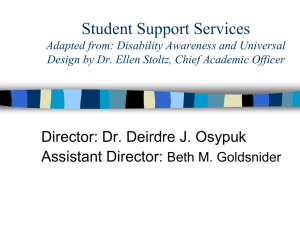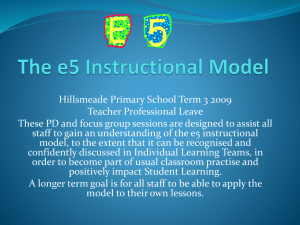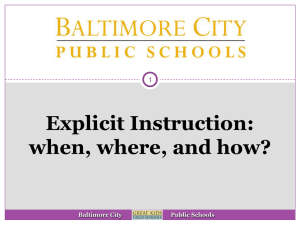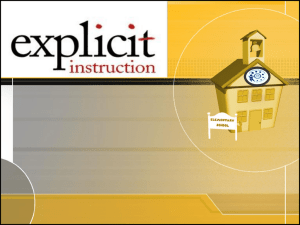Mathematics Instruction
advertisement
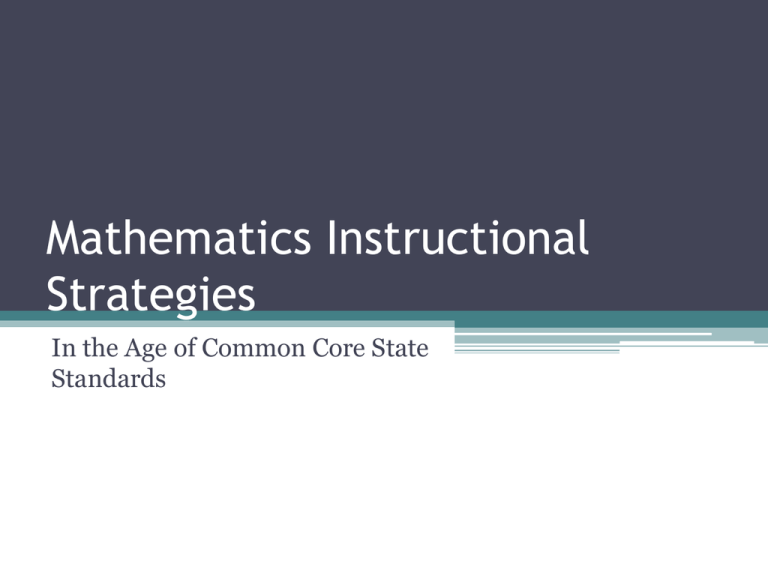
Mathematics Instructional Strategies In the Age of Common Core State Standards After School Job(4th/5th Grade) • Leonard needed to earn some money so he offered to do some extra chores for his mother after school for two weeks. His mother was trying to decide how much to pay him when Leonard suggested the idea: • “Either you pay me $1.00 every day for the two weeks, or you can pay me 1¢ for the first day, 2¢ for the second day, 4¢ for the third day, and so on, doubling my pay every day.” After School Job(4th/5th Grade) • Which option does Leonard want his mother to choose? Write a letter to Leonard’s mother suggesting the option that she should take. Be sure to include drawings that explain that will explain your mathematical thinking. After School Job(4th/5th Grade) Day Start with $1 Start with 1¢ 1 $1 1¢ 2 $1 2¢ 3 $1 4¢ 4 $1 8¢ 5 $1 16¢ 6 $1 32¢ 7 $1 64¢ 8 $1 $1.28 9 $1 $2.56 10 $1 $5.12 11 $1 $10.24 12 $1 $20.48 13 $1 $40.96 14 $1 $81.92 Instructional Strategies Chapter The purpose of this chapter is not to prescribe the usage of any particular instructional strategy, but to enhance teachers’ repertoire. •Teachers have a wide choice of instructional strategies for any given instructional goal, and effective teachers look for a fit between the material to be taught and strategies to teach it. •Ultimately, teachers and administrators must decide which instructional strategies are most effective in addressing the unique needs of individual students. The Teaching of Mathematics • must be carefully sequenced and organized to ensure that all standards are taught at some point and that prerequisite skills form the foundation for more advanced learning. • However, it should not proceed in a strictly linear order, requiring students to master each standard completely before being introduced to another. • Practice leading toward mastery can be embedded in new and challenging problems that promote conceptual understanding and fluency in mathematics. Instructional Strategies Chapter • Before discussing the many and varied instructional strategies that are at the disposal of teachers, three important topics for CA CCSSM instruction will be discussed: ▫ the Key Instructional Shifts of the CA CCSSM, ▫ the Standards for Mathematical Practice, ▫ the Critical Areas of Instruction at each grade level. Key Instructional Shifts The Mathematical Content standards emphasize key content, skills, and practices at each grade level and support three major principles: • Focus: Instruction is focused on grade level standards. • Coherence: Instruction should be attentive to learning across grades and should link major topics within grades. • Rigor: Instruction should develop conceptual understanding, procedural skill and fluency, and application. General Instructional Models Explicit Interactive Implicit Teacher serves as the Instruction includes both provider of explicit and implicit knowledge methods Teacher facilitates students learning by creating situations where students discover new knowledge and construct own meaning Much direct teacher assistance Non-direct teacher assistance Balance between direct and non-direct teacher assistance Teacher regulation of Shared regulation of learning learning Student regulation of learning Directed discovery Guided discovery Self-discovery Direct instruction Strategic instruction Self-regulated instruction Task Analysis Balance between part-towhole and whole-to-part Unit approach Behavioral Cognitive/metacognitive Holistic General Instructional Models 1. 5 E Model (interactive) ▫ Engage-Explore-Explain-Elaborate-Evaluate 2. 3 Phase Model (explicit) ▫ I do – we d0 – you do 3. Singapore Model (interactive) 4. Concept Attainment Model (interactive) 5. Cooperative Learning Model (implicit) ▫ Students work together to solve a problem and provide input 6. Cognitively Guided Instruction (implicit) 7. Problem-Based Learning (interactive) Additional Instructional Strategies 1. 2. 3. 4. Discourse in the Mathematics Classroom Student Engagement Strategies Tools for Mathematics Instruction Examples of Tasks Incorporating Math Practices 5. Real World Problems Discourse in the Mathematics Classroom • Students will be expected to communicate their understanding of mathematical concepts, receive feedback, and progress to deeper understanding. • When students communicate their mathematical learning through discussions and writing, ▫ they are able to “relate the everyday language of their world to math language and to math symbols.” • The process of writing enhances the thinking process by requiring students to collect and organize their ideas. Furthermore, as an assessment tool, student writing “provides a unique window to students’ thoughts and the way a student is thinking about an idea”. Discourse Strategies • Number Talks • 5 Practices for Orchestrating Discussions ▫ ▫ ▫ ▫ ▫ Anticipating Monitoring Selecting Sequencing Connecting Engagement Strategies Engagement Strategies 1. 2. 3. 4. 5. 6. 7. 8. 9. 10. 11. 12. 13. Appointment Clock Museum Walk Charades Clues (Barrier Games) Come to Consensus Explores and Settlers Find My Rule Find your Partner Four Corners Give One Get One Inside Outside Circle Jigsaw KWL 14. 15. 16. 17. 18. 19. 20. 21. 22. 23. 24. 25. 26. Line Up (Class Building) Making a List Numbered Heads Together Partner Up Quiz-Quiz Trade Socratic Seminar Talking Sticks Teams Share Out Think-Pair-Share Think-Write-Pair-Share Whip Around Wrap Around Y-Chart Tools For Mathematics Instruction • Visual Representations • Concrete Models • Interactive Technology In Summary … • General Instructional Models • Additional Instructional Strategies General Instructional Models Explicit Interactive Implicit Teacher serves as the Instruction includes both provider of explicit and implicit knowledge methods Teacher facilitates students learning by creating situations where students discover new knowledge and construct own meaning Much direct teacher assistance Non-direct teacher assistance Balance between direct and non-direct teacher assistance Teacher regulation of Shared regulation of learning learning Student regulation of learning Directed discovery Guided discovery Self-discovery Direct instruction Strategic instruction Self-regulated instruction Task Analysis Balance between part-towhole and whole-to-part Unit approach Behavioral Cognitive/metacognitive Holistic General Instructional Models 1. 2. 3. 4. 5. 6. 7. 5 E Model (interactive) 3 Phase Model (explicit) Singapore Model (interactive) Concept Attainment Model (interactive) Cooperative Learning Model (implicit) Cognitively Guided Instruction (implicit) Problem-Based Learning (interactive) Additional Instructional Strategies 1. 2. 3. 4. Discourse in the Mathematics Classroom Student Engagement Strategies Tools for Mathematics Instruction Examples of Tasks Incorporating Math Practices 5. Real World Problems



